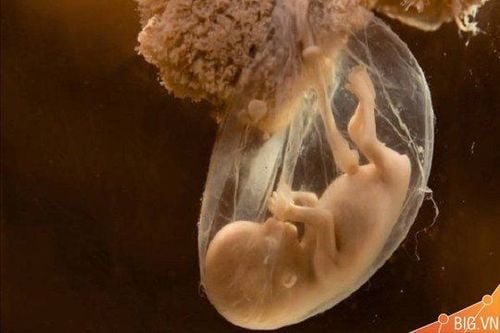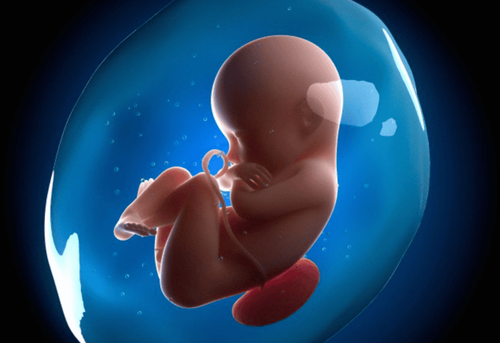This is an automatically translated article.
The article was professionally consulted by Specialist Doctor I Le Hong Lien - Department of Obstetrics and Gynecology - Vinmec Central Park International General Hospital. Doctor Lien has over 10 years of experience as a radiologist in the Department of Ultrasound at the leading hospital in the field of obstetrics and gynecology in the South - Tu Du Hospital.
And Specialist Doctor of Obstetrics and Gynecology - Department of Obstetrics and Gynecology - Vinmec Hai Phong International General Hospital.
During pregnancy, amniotic fluid plays an important role in helping to nourish and protect the fetus. So when does amniotic fluid appear after conception? How is amniotic fluid made? Let's find out the answer in the article below.
1. When does amniotic fluid appear after conception?
Amniotic fluid is a nutrient-rich environment, capable of regeneration and exchange, and plays an important role in the survival and development of the fetus in the womb. Amniotic fluid appears from the 12th day after conception. At this time, the amniotic chamber is still located in the embryonic germ and has interstitial fluid. About the next 16 days, ie the 28th day from conception, the placenta has formed a circulation and created the osmosis of amniotic fluid.
2. How is amniotic fluid made?
Amniotic fluid is made up of: fetus, amniotic membrane and maternal blood.
From the fetus : During early pregnancy, fetal skin is involved in the formation of amniotic fluid, usually this ends when the fetus is 20 weeks old, but can also last up to 28 weeks of age. depending on the baby. From the 20th week, amniotic fluid originates from the tracheobronchial tubes, because fetal plasma penetrates the respiratory mucosa of the baby. But the most important source of amniotic fluid is the urinary tract, at 16 weeks, the baby's urinary tract becomes the source of amniotic fluid production. That is why it is important to examine the fetal urogenital system when the mother has oligohydramnios.

From the amniotic membrane: The amniotic membrane that covers the umbilical cord placenta, also secretes amniotic fluid. From maternal blood: Between substances in the mother's blood and amniotic fluid, there is an exchange in the amniotic membrane. As such, amniotic fluid is always regenerated. And this cyclic regeneration is carried out through the fetus through the digestive system. We can recognize this when the fetus swallows amniotic fluid at 20 weeks. This circulatory phenomenon increases gradually when the fetus is old enough and then decreases. That's why the older the pregnancy, the higher the risk of oligohydramnios. In addition, amniotic fluid is also reabsorbed through the baby's skin, amniotic membrane, and umbilical cord.
3. The important role of amniotic fluid in fetal development
Amniotic fluid has the function of nourishing the embryo, ensuring the survival and development of the fetus. From 34 weeks and up, the fetus absorbs 300-500ml of amniotic fluid per day. This amount of amniotic fluid contributes to the formation of meconium, entering the blood to help balance the fluid in the fetus's body and partly filtered into urine for the baby. Amniotic fluid also has the function of protecting and protecting the fetus from collisions and trauma, especially ensuring a sterile environment for the baby in the amniotic sac.
Mechanically, amniotic fluid creates an environment for the fetus to develop harmoniously and to normalize the position of the fetus in the mother's genital tract in the last months of pregnancy. During labor, amniotic fluid continues to protect the fetus from the trauma of uterine contractions and infection. Amniotic fluid helps to establish the amniotic sac and dilates the mother's cervix, making it easier to clear the cervix. After the water breaks, the amniotic fluid helps to lubricate the mother's genital tract, making it easier for the baby to be born.

4. What color is amniotic fluid?
In the early stages of pregnancy, the amniotic fluid is clear white. As the fetus grows, the color of the amniotic fluid will become whiter because it contains many substances (substances that cling to the baby's skin to help protect the baby, a form of fat). The fetus is mature enough (from the 38th week), the amniotic fluid will be milky white, almost like rice water.
Amniotic fluid with other unusual colors can be a warning sign for the health of the fetus.
During pregnancy, amniotic fluid plays an equally important role as the placenta, umbilical cord, and uterus in nourishing and protecting the fetus. Based on the survey of the volume, density and color of amniotic fluid, one can predict as well as predict the health and development status of the baby still in the womb. Routine pregnancy check-ups and amniotic fluid index tests help detect amniotic fluid abnormalities early.
Please dial HOTLINE for more information or register for an appointment HERE. Download MyVinmec app to make appointments faster and to manage your bookings easily.














